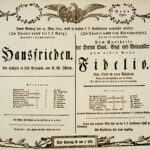From childhood Beethoven always had a sketchbook in his pocket. He used them to pen down musical ideas right as they came to him. Even though the handwriting is messy and sometimes indecipherable these books became the holy grail to his admirers. Especially the famous Landsberg 6!
In 1803 Beethoven realized his old sketchbook is getting full and went to purchase a new one. The bookbinder handed him over a 190 pages brand new sketchbook. In the coming months Beethoven made notes in this particular book, notes for groundbreaking compositions. Later, generations would know this sketchbook as the Eroica book or the Landsberg 6.
The first notes in the book are for the variations of Rule Britannia (WoO 79), probably from summer 1803. Next in line the Eroica (Symphony no. 3.) from page 4 to 91. Notes are not continuous for one composition. Eroica, for example, is broken with other compositions, like the Three Marches for piano (op. 45) on pages 28-29 or 57-58.
Early ideas for the Pastoral (Symphony no. 6., op. 68) also appear on pages 64, 96, 118 and 178. The next famous composition is the Waldstein sonata (op. 53) on several pages from 120 to 145. Leonore (Fidelio), his opera follows from 146 to 167, interrupted by the famous beginning of the Fifth Symphony (op. 67).
For many composers even one from these musical ideas would be great achievement to have in their pocket, but Beethoven was not done yet! From page 172 the Christ on the Mount of Olives (op. 85) appears and on the last pages from 180 notes for Concerto for piano, violin and cello (op.56). On the inside of the back cover a draft was written for the title-page of the Kreutzer sonata (op. 47).
Why do we call this sketchbook Landsberg 6?
Ludwig Landsberg was a Prussian-born violinist and singer who moved to Rome and lived there for twenty years. He was a serious collector of manuscripts both from Baroque and Renaissance era. Often, when visiting his home city Breslau, stopped in Vienna to buy interesting manuscripts. At the end of his life he owned eight (!) Beethoven manuscripts, this one being the sixth!
This specific one was first acquired by Artaria (a publisher) and became Notirungsbuch E in their catalogue. Then came Landsberg and purchased this special book adding to his significant collection. Landsberg died and was buried in Rome, but his collection ended up in the Berlin Royal Library in 1862. At the end of the World War II. it had disappeared from the Preussische Staatsbibiothek in Berlin and for more than thirty years was considered lost. Today it is on display in Bibliotek Jagiellonska in Krakow, Poland.





